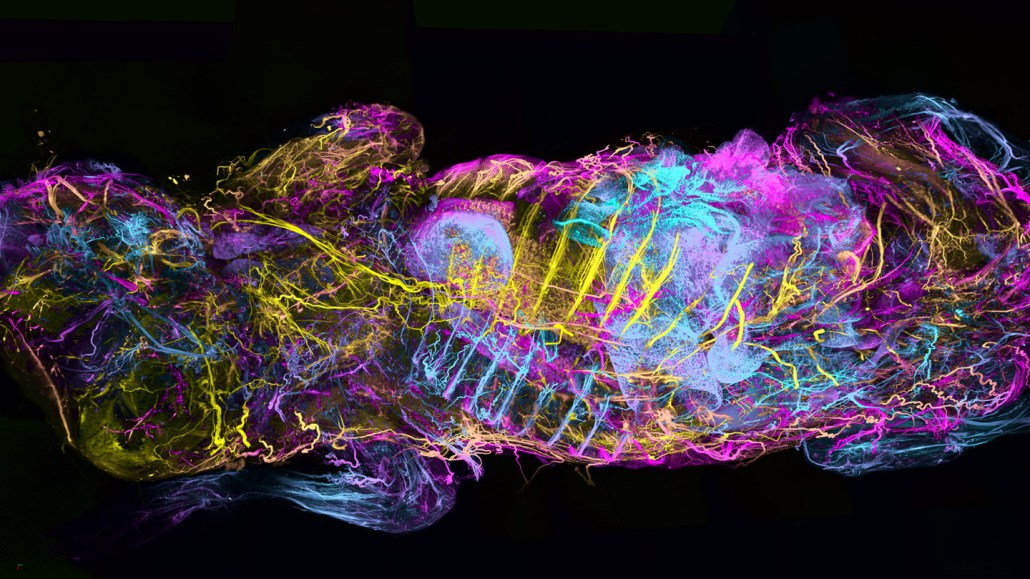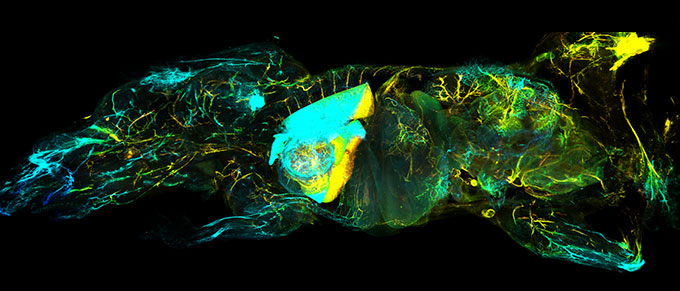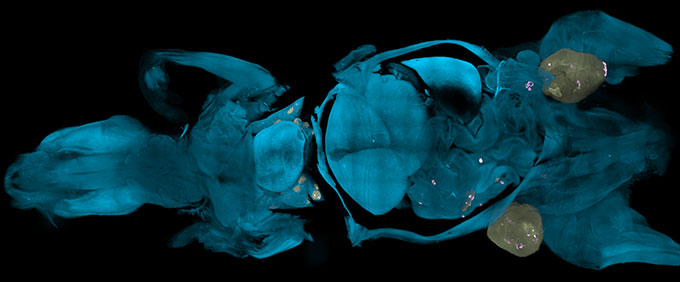A new technique creates glowing whole-body maps of mice
Like Google Maps for a body, these images reveal inner structures in sharp detail

Fluorescent proteins light up the entire nervous system of a dead and transparent mouse, using a new technique employed here. The animal’s head is on the left. Colors show how deep nerve cells are in the animal, from blue (closest to the camera) to pink and then yellow (farthest away).
© Ertürk Lab/Helmholtz Munich
Share this:
- Share via email (Opens in new window) Email
- Click to share on Facebook (Opens in new window) Facebook
- Click to share on X (Opens in new window) X
- Click to share on Pinterest (Opens in new window) Pinterest
- Click to share on Reddit (Opens in new window) Reddit
- Share to Google Classroom (Opens in new window) Google Classroom
- Click to print (Opens in new window) Print
Listen to this story:
Have feedback on the audio version of this story? Let us know!
A mouse’s entire nervous system lights up in psychedelic hues. Clumps of immune cells attacking tumors give off a ghostly glow. The vessels that make up the body’s sewer system flare brightly. These and other images are shining a new light on the inner workings of mice. These glowing views are possible due to a new imaging technique. It makes imaging a whole body cheaper and faster.
Researchers described their colorful innovation July 10 in Nature Biotechnology.
To learn about the inner workings of a body, it helps to be able to see inside. See-through mice have been made before. But existing techniques to image the insides of whole animals can be expensive and time-consuming. Sometimes they don’t even hit the right target.
An improved technique starts by chemically removing cholesterol from the tissues of dead mice. That cholesterol is an essential part of cell membranes. Taking it out created spongelike holes in tissues — without destroying them. Those holes allowed better use of chemicals that can color, or label, structures of interest.
Targeted antibodies can move through the holes to reach every corner of the body. They bind to proteins of interest everywhere they reach. Under fluorescent light, they can make targeted parts of the body glow.
The technique gives scientists an amazingly thorough peek under mouse skin.

Called wildDISCO, it can be used to create atlases of the body’s interior. The process is a bit like Google Maps for the body, says Ali Ertürk. He’s a neuroscientist who led the work at Helmholtz Munich, in Germany. In place of cars driving around to record every street, this mapping system uses antibodies. They act as streetlamps to light up cellular landmarks.
Ertürk’s group first pumped cholesterol-removing chemicals into the hearts and blood vessels of dead mice. This allows liquids to flow through the entire body. The team also added antibodies with fluorescent molecules to “tag” the tissues to which they bound. Then the team made all the tissues transparent by dunking the mouse bodies in more chemicals.
Those bodies now were ready for their close-ups.

The researchers collected images to make several maps. One shows the full network of nerves that runs beneath the skin and around organs. Another highlights the lymph system. That’s an open network of organs and vessels that helps fight off pathogens and rid the body of our cells’ wastes.
Such maps could enable many types of future studies. They might help researchers train artificial intelligence programs to simulate mouse biology. That might even reduce the need for animal experiments, Ertürk says.
This wildDISCO might guide studies on animals other than mice, adds Yijun Su. He’s an imaging specialist at Howard Hughes Medical Institute’s Janelia Research Campus. It’s in Ashburn, Va. He suspects a similar “recipe” might work in fruit flies, frogs or other common lab species. If so, he says, scientists might get clearer snapshots of their anatomy, too.







